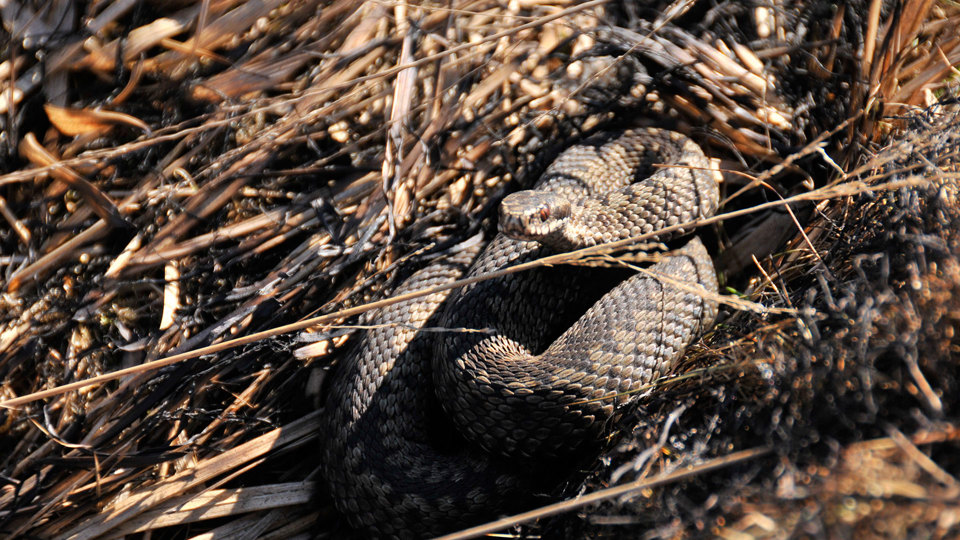Animals

Ladybird spiders Picture: Wiki Commons
Ladybird spiders
On Randbøl Hede, you may see the rare ladybird spider (eresus sandaliatus) which, in Denmark, is only found in the moors and hilly heathers of Jutland.
It may be difficult to spot Denmark's most beautiful spider, as it spends most of its life underground in a tubular web.
In spring, however, you may be lucky to spot the male crawl around in search of females on south-facing slopes where there is shelter and more sun.
It is the male's beautiful red and black colours that have given the ladybird spider. The female is black.
Roe deer
Randbøl Hede has been the home of roe deer for more than 100 years. They arrived when the health of the plantations improved and, nowadays, many roe deer live 24/7 on the open moor where there is plenty of food. Often, roe deer walk around on their own.
Red deer
Red deer thrive on the expanses of moors and forests. Since 1960, Frederikshåb Plantage has been the home of permanent herds of red deer. They are shyer than roe deer and are best observed on those areas of the moors where people rarely come - and usually early in the morning or at dusk. Red deer are often observed in herds.

An Adders at Randbøl Hede. Picture: Gert Hougaard Rasmussen
Adders
There are many adders on the moor, yet they are rarely seen. They disappear as soon as they hear people approaching.
If you would like to observe adders, then visit in early spring when they are looking for a sunny spot to soak up some heat.
They feed on mice and lizards that are swallowed whole. The adder is up to 80 cm long and may be recognised on the zigzag pattern on its back.
If you are bitten by an adder, seek medical assistance. Often, the doctor chooses not to treat the bite, because the initial “dry bite” of an adder contains a minimal amount of poison.
Read more on the adder in the encyclopaedia of species (in Danish)
Curlew
This large bird first bred Denmark in 1934 - on Randbøl Hede.
The curlew, which is the size of a crow and Denmark's largest wader, may be recognized on its long, curved beak.
The curlew may be up to 37 years old and, as one of the largest waders of the world, it has a wing span of approximately one meter. On spring mornings, its melodic whistling may be heard across the moor. It builds its nest directly on the ground.
Read more on the curlew at dofbasen.dk (in Danish)
Wood larks
Wood larks are a little smaller than skylarks, and they are sometimes spotted in the southern part of Randbøl Hede.
Read more on the wood lark in the encyclopaedia of species (in Danish)
Great grey shrike. Picture: Allan Bech
Great grey shrikes and red-backed shrikes
The relatively rare great grey shrike is also called "the watchful butcher" because it skewers some of its prey on thorns to collect supplies. It typically sits in the top of a shrub or a tree looking for food. You may recognise it on its grey plumage with black wings, black eye markings and its long tail.
The more common red-backed shrike may also be found here.
Read more on the shrike at dofbasen.dk (in Danish)
Nightjar. Picture: Henrik Hougaard Larsen
Nightjars
The nightjar thrives in Frederikshåb Plantage. It has grey-brown plumage and is the size of a blackbird. During the breeding season of May-June, you may hear the male's whirling, spinning wheel song and the clapping sounds of the male throwing together his wings in flight. You may lure the nightjar to you by imitating that sound by clapping your hands. As the name suggests, the nightjar is only active at night. In the olden days, it was called the goat sucker because it was thought that it used its big beak to milk the goats at night.
Cranes. Picture: Allan Bech
Cranes
Cranes visit Randbøl Hede in ever growing numbers and it is assumed that there are breeding pairs here. The largest cranes weigh up to seven kilos and have a wing span of more than two meters.
In future, it may be possible to hear more trumpeting and watch the mating dance of the cranes at Randbøl Hede.
Read more on the cranes in the encyclopaedia of species (in Danish)
Plants
Hedelyng. Foto: Gert Hougaard Rasmussen
Heather
Naturally, the superstar of Randbøl Hede is the heather. It flowers in August, where large areas are covered in a violet carpet. In the slightly wetter parts of the moor, you may find bell heather which has large, pink and bell-shaped flowers.
Read more on heathers at fugleognatur.dk (in Danish)
The heather is not the only plant blossoming on the moor. There is also a relatively rich flora of, for example, mountain tobacco, the carnivorous sun dew, the protected spring pasqueflower and the rare marsh gentian. But the moor also offers an abundance of berries, such as cranberries, cowberries, blueberries, bog whortleberries and crowberries.
purple moor grass. Picture: Gert Hougaard Rasmussen
Enemy No 1 of the moor - purple moor grass
Due to the preference for heather, Randbøl Hede is also a nature area where some plants are actively fought back.
Enemy number one is the purple moor grass which nearly turned the heathery moor into a grassland. As soon as purple moor grass is allowed to spread, it makes it impossible for other plants to establish themselves, thus eliminating the animals that live of the heather. It has been extremely difficult to fight purple moor grass by mowing, grazing and burning. The most effective means has been to peel off the top layer of organic soil – the heath turf - exactly like the moorland farmers did.
